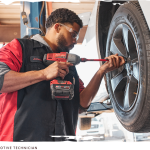Today’s automotive technicians don’t just turn wrenches. They diagnose problems using computerized equipment, follow specs and checklists, and help customers understand what’s going on. The U.S. Bureau of Labor Statistics notes that technicians regularly use scan tools, work on computer-controlled systems, and interact directly with drivers when reviewing needed repairs.
If you’re wondering what it takes to succeed in the shop, here are five essential skills auto technicians should build.
1. A Problem-Solving Mindset
One of the most important skills for auto technicians is to move beyond symptoms and find the root cause. That means knowing how to pull diagnostic trouble codes (DTCs), check fuel trim data, review service information, and create a step-by-step test plan.
Technicians use computerized diagnostic devices daily — scan tools, lab scopes, and smoke machines — to confirm faults and verify repairs.
Real-World Shop Example
A customer comes in with a check engine light and a misfiring engine. The tech doesn’t just replace spark plugs at random. They pull the DTCs, analyze fuel trims, perform a smoke test to check for vacuum leaks, and confirm the fix with a complete drive cycle. It’s a disciplined process taught in skilled trades training programs like AAI’s Automotive Service Technician program.
2. Attention to Detail and Specs
Among the best auto tech traits is an attention to specs and the critical details and tolerances for each component. Correct torque specs, brake service, wheel alignments, and fluid checks all depend on following procedures carefully — and these vary by manufacturer and model. Small oversights can lead to comebacks that cost shops time and money.
Both BLS and O*NET highlight tasks like repairing brakes, testing and adjusting systems, and following manufacturer checklists.
Real-World Shop Example
During a brake service, a technician measures rotor thickness, installs components using the proper torque sequence, bleeds the hydraulic system correctly, road-tests the vehicle, and documents the results. That combination of skill and detail helps create a repair that holds up.
3. Electrical and Electronics Literacy, Including ADAS Basics
To succeed as a mechanic, you should be comfortable with wiring diagrams, sensors, actuators, and networks like the CAN bus. Vehicles rely heavily on electronics, and technicians must know how to use a multimeter or scope to confirm what’s working, and what isn’t.
Driver assistance features (ADAS) are also becoming common. The National Highway Traffic Safety Administration (NHTSA) outlines technologies like lane keeping assist, adaptive cruise control, and automatic emergency braking, which will be standard by model year 2029 (NHTSA, Federal Register). Shops often need to perform ADAS calibrations after repairs like windshield replacement, alignment, or suspension work.
Skilled training is vital today. Without these competencies, a shop just can’t take a chance on a new hire. That’s why AAI’s Automotive Service Technician program includes skill-based learning in electronic and electrical systems.
Real-World Shop Example
After replacing a windshield, a technician follows OEM instructions to calibrate the forward camera, using either a static target setup or a dynamic road test to confirm the systems operate correctly.
4. Communication and Customer Service
Even the most skilled repair isn’t done until the customer understands what was done and why. O*NET and BLS both list customer communication as part of a technician’s role — conferring with drivers, explaining needed work, and writing accurate repair orders.
Technicians build trust by translating technical issues into plain language and setting clear expectations about cost and timing.
Real-World Shop Example
After replacing tie rod ends, a technician explains that an alignment is necessary. They use a simple diagram or even a photo from the shop computer to show how steering angles change, helping the customer feel confident in approving the additional work.
5. Learning, Credentials, and Safety
The industry doesn’t stand still, which is why ongoing training is critical. Certifications also demonstrate proven skill, giving employers the confidence they need to trust a new hire with a customer’s car.
- ASE certifications: The A-series covers core automotive areas. The L3 credential focuses on hybrid and electric vehicles, and the L4 covers ADAS. (ASE)
- EPA Section 609: Required for anyone servicing mobile vehicle A/C systems or purchasing refrigerant. (US EPA)
Real-World Shop Example
A certified technician follows a documented high-voltage disable process before servicing the A/C system on a hybrid vehicle, avoiding electrical hazards and keeping themselves and the shop safe.
Ready to build these skills?
At Arizona Automotive Institute, you can train on real vehicles with guidance from instructors who bring their shop experience into the lab. AAI’s Automotive Service Technician program focuses on the practical skills that help prepare you for entry-level roles in the field. Financial aid is available for those who qualify.
Frequently Asked Questions (FAQ)
Which ASE tests should a beginner start with?
Most entry-level technicians begin with the G1 Maintenance and Light Repair test. As skills progress, the A-series certifications become relevant. ASE Test Series
Do I need certification to work on car air conditioning?
Yes. The EPA requires Section 609 certification to service mobile vehicle A/C systems or purchase refrigerants. EPA Section 609
Will I need to understand ADAS to get hired?
Many shops regularly encounter ADAS-related work. NHTSA notes that features like automatic emergency braking will be standard by 2029. For credentials, consider the ASE L4 credential for ADAS knowledge.
How technical do the electronics get?
According to BLS, technicians increasingly work on electronic systems daily. With training, complex tasks like wiring tests and calibrations become manageable.
Disclaimers: Information within this blog is for general information purposes only. AAI does not assume or guarantee certification/licensures, specific job/career positions, income earning potential, or salary expectations based on the programs offered at AAI. Career and program information statements in this blog do not guarantee that programs or other information mentioned are offered at AAI.
Information within this blog is for general information purposes only. AAI does not assume or guarantee certification/licensures, specific job/career positions, income earning potential or salary expectations based on the programs offered at AAI. Career and program information statements in this blog do not guarantee that programs or other information mentioned are offered at AAI.





